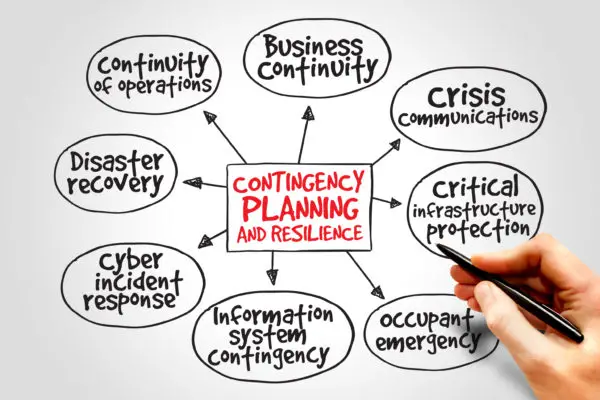Auditing a Business Continuity Plan (BCP) is critical to ensure the plan is effective and aligns with the organization’s objectives. Here’s a step-by-step process on how to audit a BCP:
1. Review the BCP Documentation: Start by examining the current BCP documents. Ensure they are comprehensive and include all critical components, such as risk assessments, business impact analyses, recovery strategies, and communication plans. Assess whether the plan addresses all potential threats and business functions. (TechTarget)
2. Evaluate the Scope and Objectives: Confirm that the scope and objectives of the BCP are clearly defined and aligned with the organization’s goals. The BCP should cover all essential aspects of the business.
3. Assess Risk Assessment and Business Impact Analysis (BIA): Check if the BCP is based on a thorough risk assessment and BIA. The BIA should prioritize critical business functions and processes and the impact of their disruption.
4. Check Compliance with Standards and Regulations: Ensure the BCP complies with relevant industry standards, best practices, and legal or regulatory requirements.
5. Verify Roles and Responsibilities: Review the defined roles and responsibilities for the business continuity team and other stakeholders. Confirm that everyone understands their tasks and responsibilities.
6. Examine Training and Awareness Programs: Look at the training programs for staff involved in the BCP. Determine if these programs are adequate and if staff are aware of their roles in an emergency.
7. Test the Plan: Evaluate the testing and exercise schedule. Check if tests are conducted regularly and lessons learned are documented and incorporated into the BCP.
8. Review Communication Plans: Assess the effectiveness of communication plans, both internal and external. Ensure that contact lists are current and communication channels are established.
9. Inspect Data Backup and Recovery Procedures: Confirm that data backup and recovery procedures are in place, regularly tested, and capable of restoring systems within the required timeframes.
10. Analyze Third-Party Dependencies: If the BCP relies on third-party services, verify that these providers also have effective continuity plans and that their obligations are clearly documented.
11. Consider Alternate Arrangements: Ensure there are alternate arrangements for critical operations, such as secondary locations, in case primary sites are inaccessible.
12. Evaluate Incident Response: Assess how the BCP addresses the immediate incident response to ensure safety, asset protection, and the initiation of the continuity plan.
13. Review Recovery Strategies: Ensure the recovery strategies are realistic, practical, and capable of achieving each critical function’s recovery time objectives (RTOs) and recovery point objectives (RPOs).
14. Check Plan Accessibility: The BCP should be easily accessible to all relevant personnel, both in electronic and physical formats, if necessary.
15. Examine Maintenance and Updating Processes: Review the processes in place for maintaining and updating the BCP. The plan should be a living document that is regularly reviewed and updated to reflect changes in the business environment, technology, and personnel.
16. Document Audit Findings: Throughout the audit, document any weaknesses, gaps, or areas for improvement. Also, note any strengths and best practices that can be leveraged.
17. Provide Recommendations: Based on the audit findings, provide clear and actionable recommendations to address any issues identified. Recommendations should prioritize critical areas that impact the organization’s ability to recover from a disruption.
18. Create an Audit Report: Compile all findings and recommendations into a structured audit report. This report should be presented to senior management and other stakeholders, outlining the effectiveness of the BCP and the necessary actions to enhance it.
19. Follow-Up: Ensure that there is a follow-up process to track the implementation of audit recommendations. This might involve setting deadlines, assigning responsibilities, and monitoring progress.
20. Continuous Improvement: Promote a culture of continuous improvement where feedback from BCP tests, actual incidents, and audits contribute to the ongoing enhancement of the business continuity planning process.

In an era where business landscapes are perpetually evolving, the importance of a robust Business Continuity Plan (BCP) cannot be understated. A BCP ensures that a business can withstand and efficiently recover from unforeseen disruptions such as natural disasters, cyber-attacks, or any other potential threats.
However, the mere existence of a BCP does not guarantee its effectiveness; hence, it is necessary to audit these plans periodically.
Auditing a BCP validates its robustness and identifies potential gaps that may hinder an organization’s ability to resume business operations promptly post-disruption.
In this discussion, we will systematically explore the process of auditing a BCP, the relevant regulatory requirements, and how risk management strategies are assessed.
As we unfold the layers of this topic, you will discover the critical role an audit plays in fortifying a BCP and why it is indispensable in today’s volatile business environment.
Key Takeaways
- A business continuity plan (BCP) audit is essential for validating the plan’s effectiveness and identifying potential gaps.
- Auditing BCPs enhances security standards, governance, and adherence to the BCP checklist.
- Reviewing relevant documentation, such as BCPs, DRPs, and previous audit reports, is crucial for an effective audit.
- Analyzing BCP documentation helps identify potential interruptions, evaluate recovery procedures, and enhance organizational resilience.
Introduction
Understanding the fundamental aspects of a Business Continuity Plan (BCP) and its significance in ensuring organizational resilience is pivotal before delving into the nuances of an audit process.
A business continuity plan audit is a systematic evaluation of the BCP by an internal audit team to ensure it meets the organization’s needs and complies with regulatory requirements.
The audit plan involves assessing the effectiveness of continuity management and audit controls in place.
A robust business continuity planning process helps build a resilient business continuity program.
The audit team reviews the business continuity plans and recommends improvements, ensuring the organization can effectively respond to disruptions, enhancing resilience and maintaining continuity.
Definition of business continuity plan (BCP)
Having discussed the fundamental aspects and significance of a business continuity plan audit, it is now essential to define what a Business Continuity Plan (BCP) entails.
A business continuity plan is a strategic blueprint that a company uses to maintain continuous business functions during and after a disaster. It forms the heart of the business continuity planning process and business continuity management.
An effective business continuity plan outlines the business continuity roles of staff and provides a business continuity plan template for the company’s use. The definition of a business continuity plan also includes the continuity management policy and procedures for business continuity plan validation.
In essence, continuity plans ensure the preservation of a company’s functions in the face of adversity.
Importance of auditing BCPs for organizations
The auditing of Business Continuity Plans (BCPs) holds paramount importance for organizations as it provides a robust framework to evaluate the effectiveness of these plans in maintaining uninterrupted business operations during unforeseen circumstances.
The importance of auditing BCPs for organizations lies in the following:
- Identifying audit findings and gaps in the business continuity planning program enhances operational security standard business continuity planning.
- Facilitating continuity planning program governance and ensuring the business continuity plan checklist adherence.
- Strengthening the efficiency of the business continuity awareness team and the business continuity planning coordinator.
- Ensuring continuity strategies are functional, effective, and up-to-date through an independent assessment.
The audit reinforces the organization’s resilience and preparedness, safeguarding its reputation and financial stability.
Understand the Purpose and Scope of the Audit
Understanding the purpose and scope of the audit is a pivotal stage in a Business Continuity Plan (BCP) auditing process.
This involves defining the precise objective of the audit and identifying key stakeholders who are integral to the BCP audit process.
Further, it is important to determine the scope and boundaries of the audit, ensuring all relevant aspects of the BCP are thoroughly evaluated.
Define the objective of the audit
In business continuity planning, defining the objective of the audit involves distinguishing the key areas of focus and the overall purpose of the evaluation.
Setting objectives is integral to an effective audit, as it guides the internal audit team in developing audit programs and implementing audit projects.
The objectives typically centre around:
- Ensuring the approach to business continuity aligns with the objectives of the mission.
- Evaluating the robustness of the business continuity procedures.
- Inspecting the effectiveness of the audit contingency and business continuity measures.
- Assessing the business continuity metrics related to critical business functions.
When clearly defined, these objectives equip the internal audit team with a clear focus, ensuring a thorough and effective evaluation of the business’s continuity plan.

Identify key stakeholders involved in the BCP audit process
Once the audit objectives are clearly defined, it becomes crucial to recognize and involve the key stakeholders in the business continuity plan (BCP) audit process. During the audit-scoping phase, it is essential to identify internal and external stakeholders.
Internal auditing typically involves program managers who oversee the BCP, ensuring its effectiveness and management process. Their insights can significantly shape the audit report.
On the other hand, external stakeholders may include regulators, customers, or suppliers. Their expectations can influence the audit process, promoting transparency and accountability in management communications.
Determine the scope and boundaries of the BCP audit
Establishing the scope and boundaries of the BCP audit is a critical step that ensures all necessary areas of the business continuity plan are thoroughly evaluated for compliance and effectiveness.
In determining the scope, the audit community should consider the continuity of services, available audit resources, and the extent of the risk assessment and business impact analysis already conducted.
The scope and boundaries should encompass:
- The entire business continuity plan, including all documentation notes and audit paperwork.
- All processes and functions were critical for the continuity of services.
- The risk assessment methods used for the plan.
- The business impact analysis and its findings.
This will help determine if the plan can effectively manage potential disruptions and maintain business operations.
Review Relevant Documentation
In the process of auditing a Business Continuity Plan (BCP), it is crucial to review relevant documentation. This includes obtaining and analyzing copies of existing BCPs, Disaster Recovery Plans (DRPs), and other associated documents.
Obtain copies of existing BCPs, disaster recovery plans (DRPs), and related documents
To effectively audit a Business Continuity Plan (BCP) and Disaster Recovery Plan (DRP), obtaining copies of these existing documents and any related materials is a crucial initial step.
This procedure allows for a comprehensive review and analysis of the corporate resiliency efforts.
The documents to obtain copies of are:
- Business Continuity Plan outlines the procedures to maintain operations during a disaster.
- Disaster Recovery Plan: This specifies the steps for recovering vital technology infrastructure.
- Related Documents may include departmental contingency plans, risk assessments, and testing records.
- Other relevant records: These could be previous audit reports or improvement plans.
These documents provide insights into an organisation’s preparedness and are essential for testing the robustness of the BCP and DRP.
Analyze documentation to gain insights into current BCP practices and procedures
Delving into the obtained documentation provides valuable insight into the current BCP practices and procedures, revealing the organization’s resilience strategy during crisis situations.
To analyze documentation effectively, attention should be given to the comprehensive business-impact analysis, testing processes, and procedures for recovery. These elements help in understanding the continuity and disaster recovery plans.
The following table presents a simplistic view of key areas to focus on during the analysis:
| Area of Focus | Why It’s Important |
|---|---|
| Comprehensive Business-Impact Analysis | To gauge potential effects of interruptions on business operations and processes |
| Testing Processes | To validate the effectiveness of the continuity and recovery strategy |
| Procedures for Recovery | To ensure a quick and efficient recovery process post-disaster |
This assessment ensures a robust testing of contingency plans, thereby enhancing the organization’s resilience.
Evaluate Compliance with Regulatory Requirements
Evaluating compliance with regulatory requirements in a business continuity plan involves thoroughly assessing the plan’s adherence to applicable laws, regulations, and industry standards.
Identifying any potential gaps or non-compliance issues within the plan is crucial.
This step ensures the business continuity plan is effective and legally sound, reducing the risk of penalties or sanctions due to non-compliance.
Assess adherence to relevant laws, regulations, and industry standards
Ensuring strict compliance with all relevant laws, regulations, and industry standards is paramount in business continuity planning.
This not only safeguards the organisation’s operations but also instils management confidence by mitigating the level of risk.
When assessing adherence, consider the following steps:
- Employ external specialist resources to ensure professional practices are being followed.
- Conduct thorough auditing across all departments to verify the extent of auditing performed.
- Generate detailed findings to highlight areas of concern or noncompliance.
- Implement assurance measures to address any identified risk.
Such an approach ensures complete and effective compliance, serving as a strong foundation for robust business continuity planning.
Identify any gaps or non-compliance issues
Building upon the robust foundation of compliance, it becomes crucial to dissect the business continuity plans further, identifying potential gaps or instances of non-compliance with regulatory requirements.
Use your audit resources to evaluate the plan’s maintenance and check for compliance issues that could undermine recovery teams’ effectiveness.
Your risk appetite will guide the thoroughness of your audit and influence your draft audit opinion report.
The program management balance consideration is vital in maintaining robust business continuity plans, ensuring mission-critical operations remain unaffected during disruptions. Unresolved compliance issues can threaten this balance.
Therefore, a comprehensive audit that identifies and addresses these potential gaps is necessary for the continued efficacy of your business continuity plan.
Testing contingency plans is pivotal in ensuring the resilience and continuity of critical business processes.
Maintaining these plans often involves balancing conflicting priorities among managers, setting realistic time frames, and emphasizing effective communication strategies.
The involvement of formal observers and active participation from people across the organization, including service providers, is crucial.
This collaborative effort enables executive management to develop suitable plans tailored to withstand major disasters through a rational assessment of potential risks, recovery times, and recovery window objectives.
Preparing for a catastrophic event is not just a one-time effort but an ongoing, day-in, day-out commitment to maintaining normal operations.
It includes regular training and ensuring relevant employee preparedness to uphold the mission’s objectives. Activation procedures must be clear, with all staff, especially senior executives, having a thorough familiarity with these procedures.
It’s also important to identify non-essential processes that can be deprioritized in a crisis to focus on critical functions.
Preliminary findings from government auditing and the availability of audit resources can provide valuable insights for refining these plans. Ultimately, the goal is to transition smoothly from actual disaster efforts to regular operations with minimal disruption.
Assess Risk Management Strategies
Understanding and evaluating risk management strategies is integral to auditing a business continuity plan. These strategies are designed to mitigate the impact of disruptive events and ensure an effective response.
The business continuity manager should consider internal and external resources, training practices, and assurance requirements.
When assessing risk management strategies, focus on:
- The preparedness for an incident or event, including the availability and allocation of resources.
- The extent and effectiveness of training practices for employees.
- The response strategies to disruptive events and their potential impact on the business.
- The assurance requirements and how they are met provide confidence in the risk management strategies.
An effective audit will identify areas of strength and opportunities for improvement, enhancing overall business resilience.

Conclusion
Auditing a business continuity plan is a strategic imperative for organizations to ensure their resilience and readiness in the face of potential disruptions.
A systematic audit reviews relevant documentation evaluates regulatory compliance, and assesses risk management strategies.
Thus, a well-conducted audit can help organizations identify potential gaps, mitigate risks, and enhance their business continuity capacities, safeguarding their operations, reputation, and overall business sustainability.

Chris Ekai is a Risk Management expert with over 10 years of experience in the field. He has a Master’s(MSc) degree in Risk Management from University of Portsmouth and is a CPA and Finance professional. He currently works as a Content Manager at Risk Publishing, writing about Enterprise Risk Management, Business Continuity Management and Project Management.

